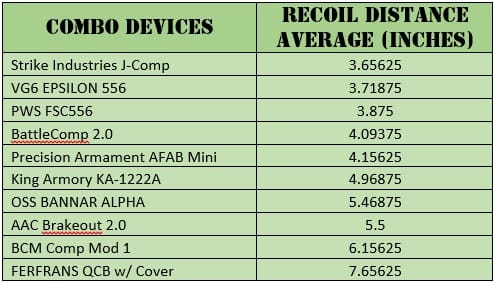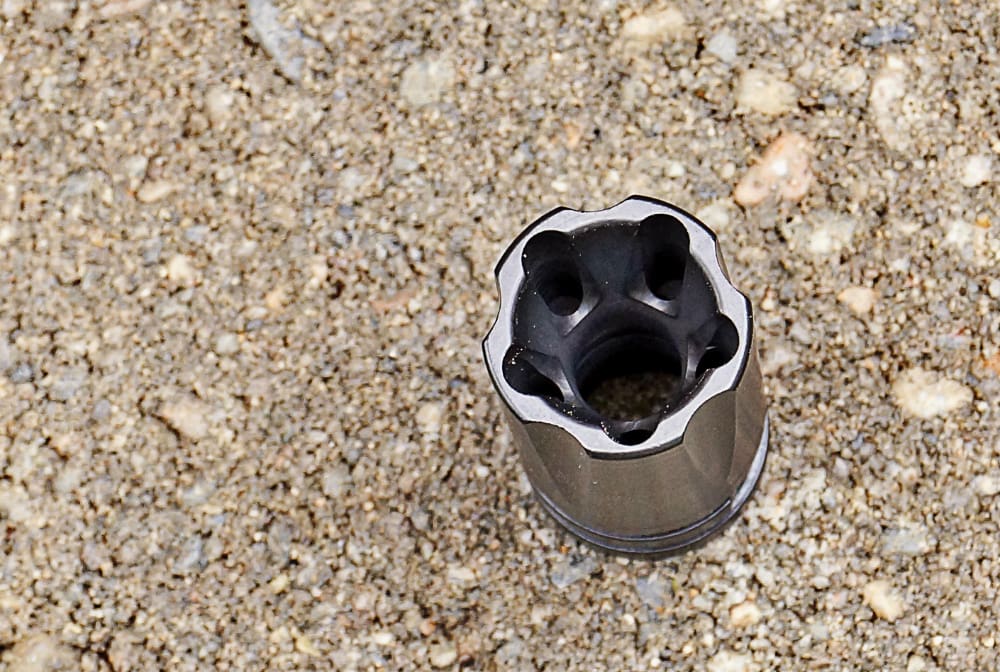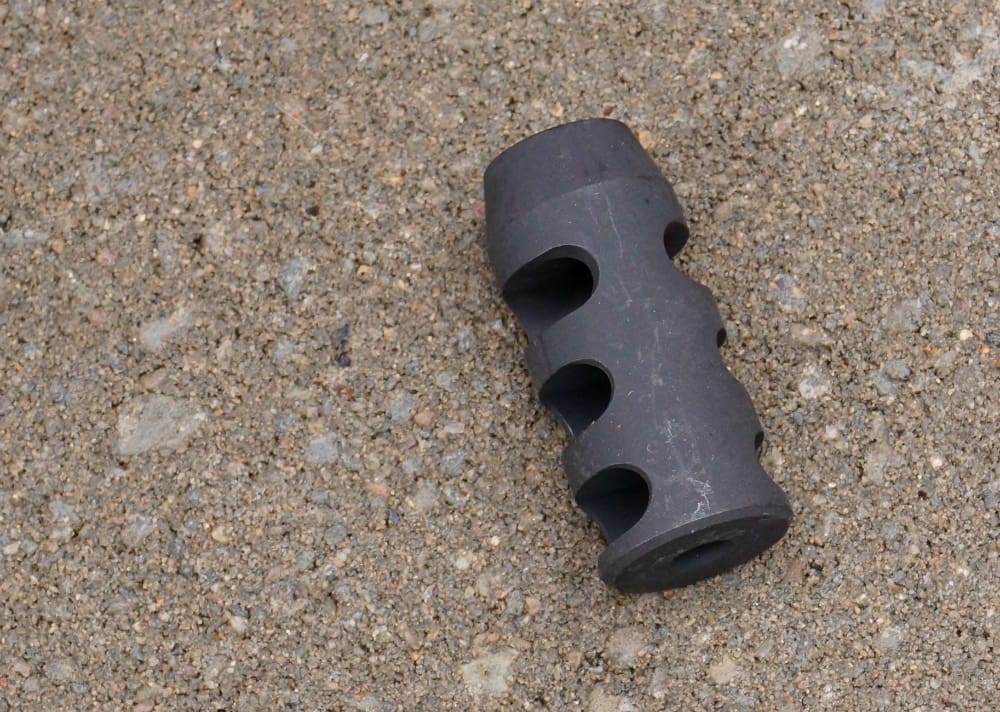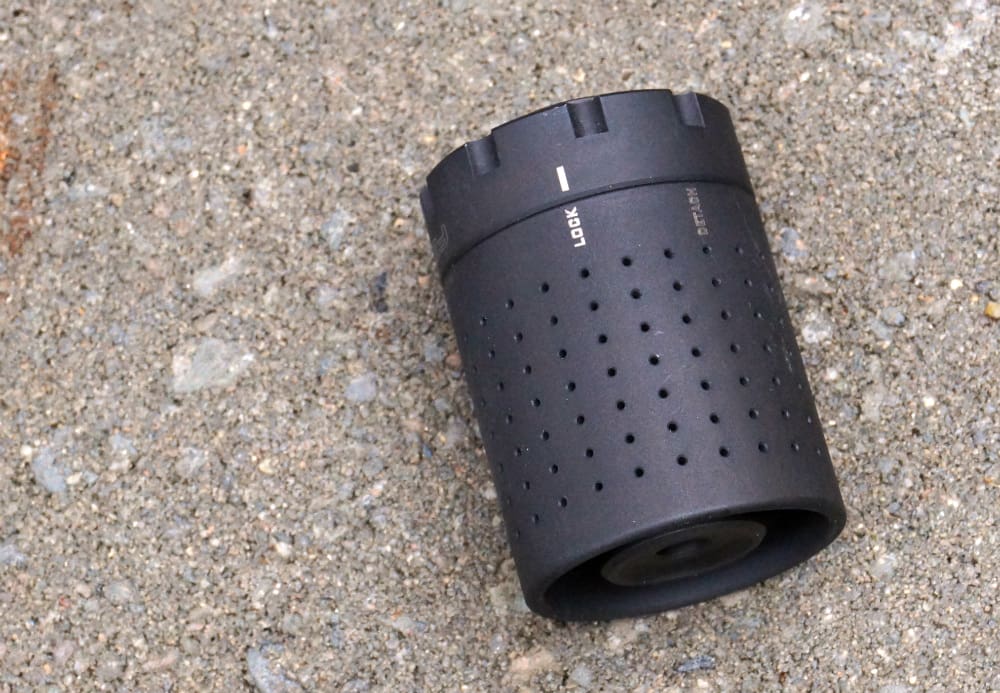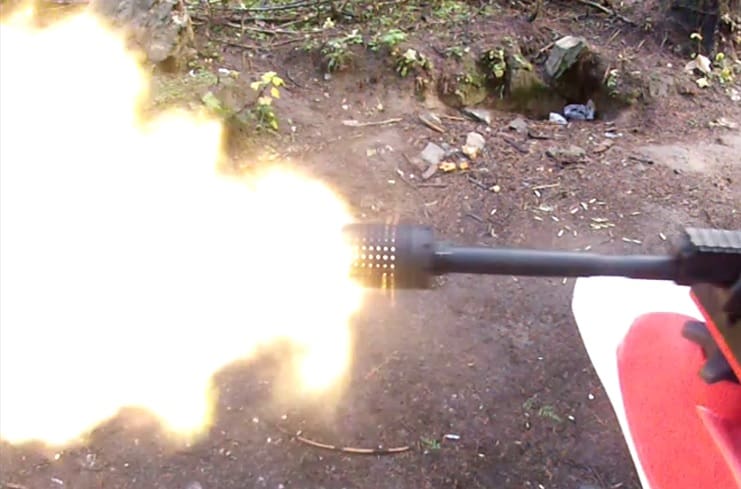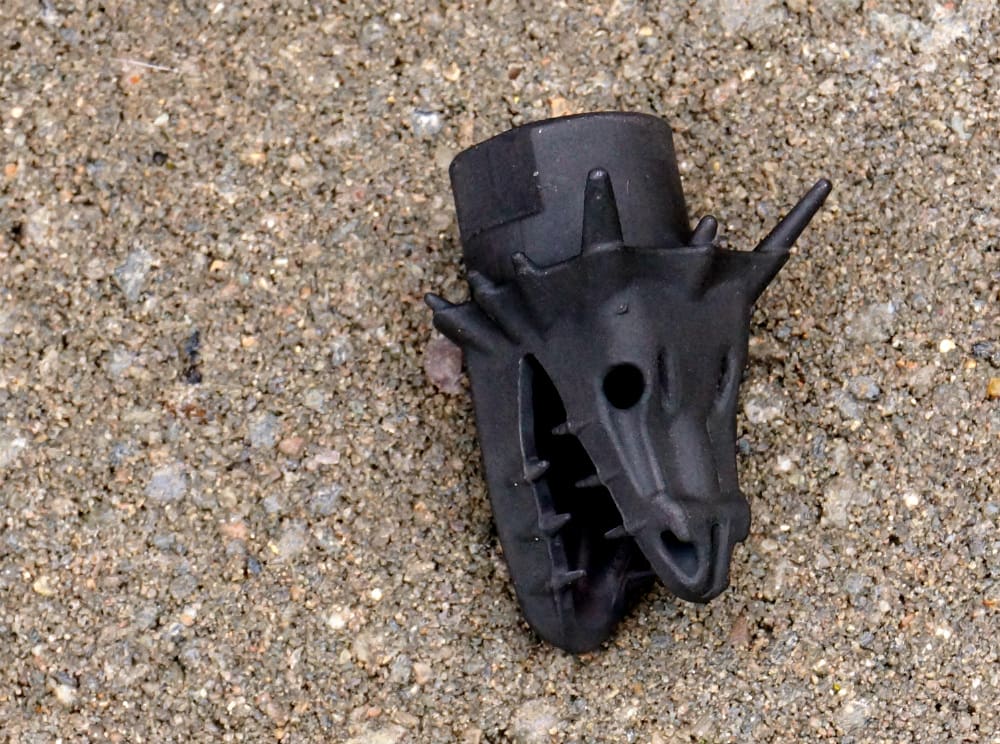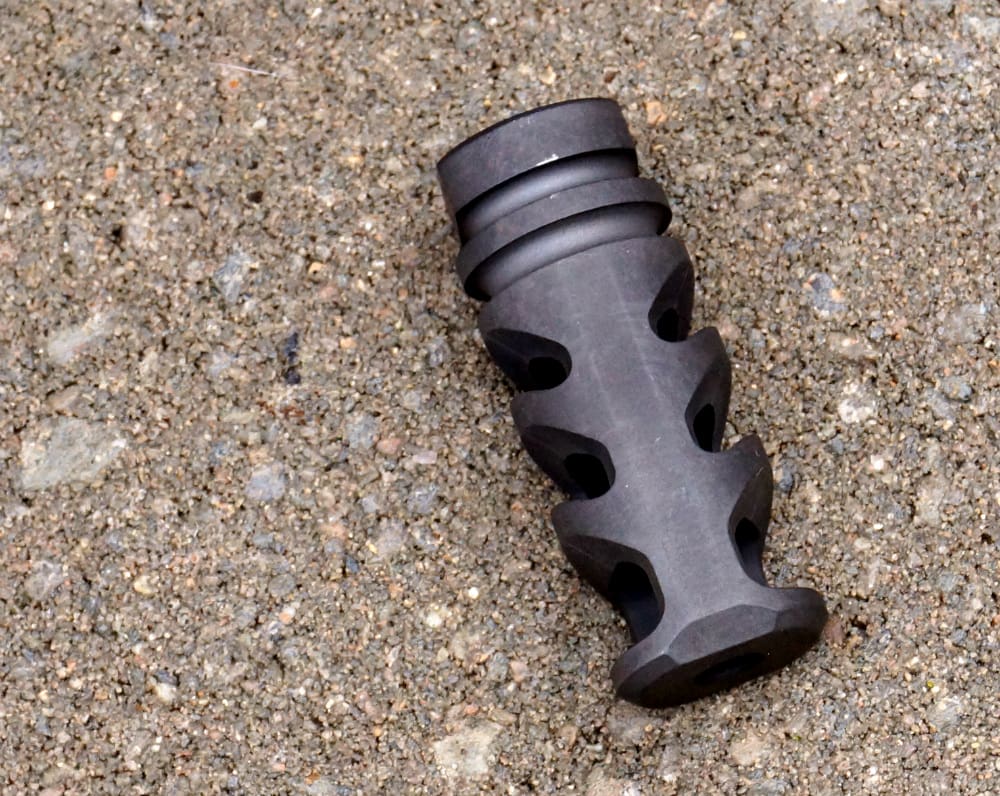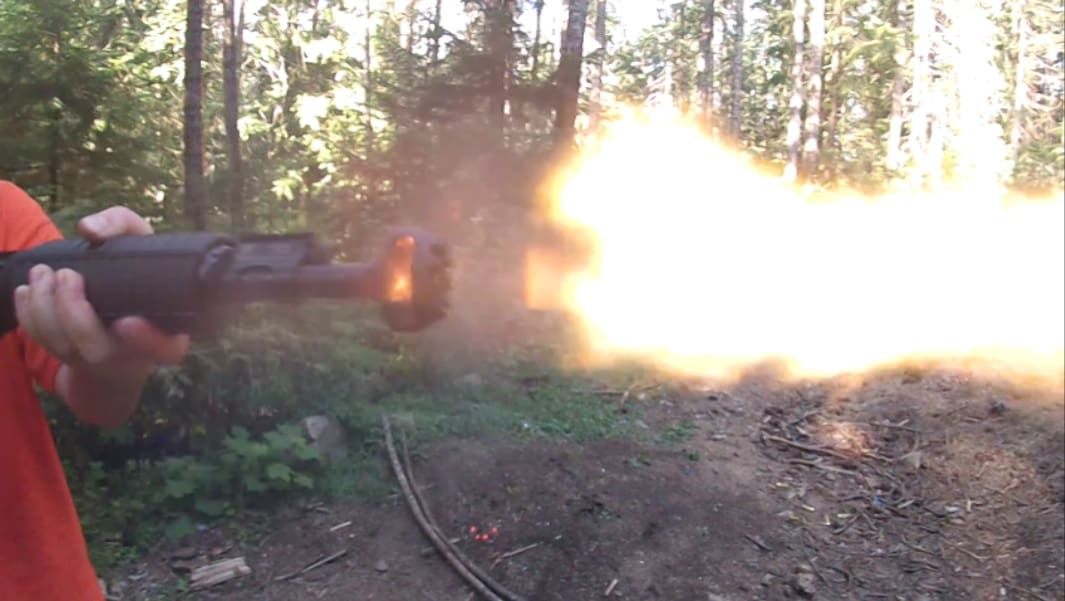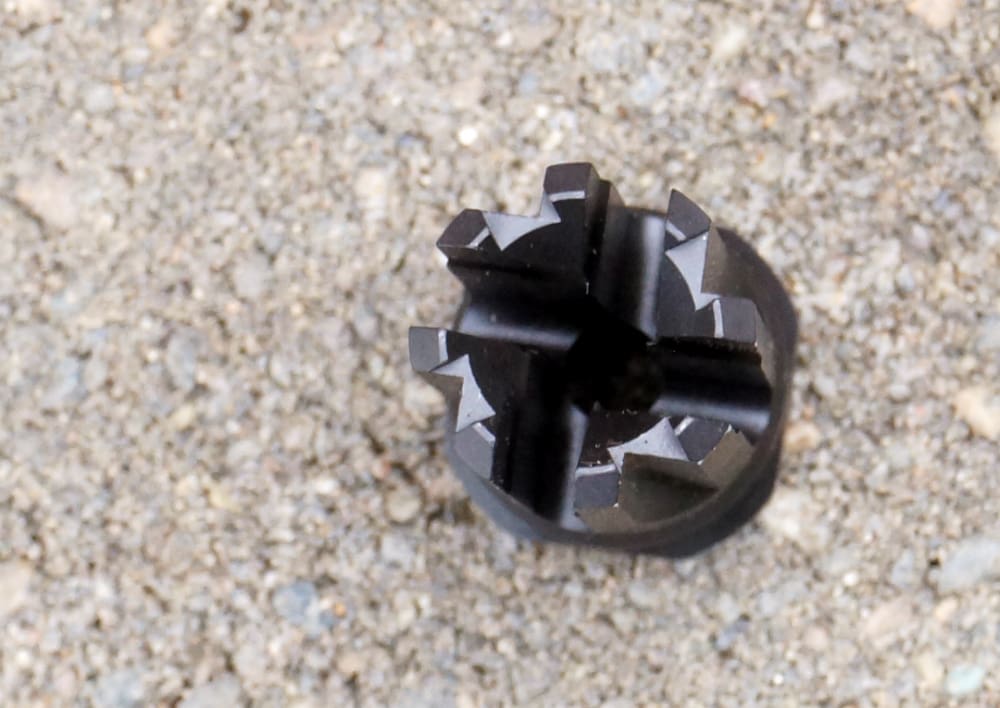King Armory contacted TTAG and asked if we’d like to review their KA-1222A muzzle brake/flash hider. As there are just way too many options from way too many manufacturers to review them individually, the project quickly escalated into doing a bit of a “shootout” with muzzle devices from multiple companies. Hopefully we’ve achieved a decent mix of well-known units from well-known manufacturers as well as some from smaller shops that many folks may not be familiar with. Basically, the intention here is to highlight a variety of muzzle device options — we gathered 35! — state my blunt opinion on machining, fit/finish, and utility plus any items of note, along with relevant stats. Since many of these devices specifically claim to reduce recoil I created a test rig to measure just that, and a winner has been declared . . .
EDIT: This is the first test I did, but it hasn’t been the last. The second 5.56 muzzle brake test is HERE, the third is HERE, the first 5.56 flash hiding test HERE, the second 5.56 flash hiding test HERE, and the first .308 brake test HERE. You may also be interested in the AR-15 Drop-In Trigger Roundup HERE.
These tests are expensive, but I’d love to do more. I’ve purchased air pressure sensors designed to log blast waves so we can compare the amount of concussion each muzzle device generates, and these will be used in test four. But I have a lot of brakes to round up for that and the funding is low. I also want to do another AR-15 trigger roundup (component triggers this time) and a couple of flashlight roundups (tactical and gun-mounted). Please consider supporting this sort of testing via my Patreon page. As a Patron you can also get free stuff, join live streams, gain early access, and more.
Recoil Testing
First, a quick note: not all of these muzzle devices are brakes/comps, or were otherwise designed to mitigate recoil. For some that is the primary goal. Some balance recoil management with flash hiding, and some have no recoil reduction consideration whatsoever (e.g. dedicated flash hiders or a linear compensators). For most brakes and comps, felt recoil reduction is only one goal anyway, with the other primary benefit being the reduction of muzzle movement in any other direction. The slow-mo footage for each device in the following video does show some noticeable differences in up/down muzzle movement as well as flash, but this test was specifically designed for measuring recoil — rearward energy.
Keep in mind that we’re also talking about the fairly minor recoil of .223/5.56 here, and many prospective purchasers will put recoil reduction at the bottom of their list behind other considerations like reducing flash and concussion.
https://www.youtube.com/watch?v=3FD-Rou9-9A
With my gas piston AR-15 strapped in a rest and the gas block turned to “off,” which means the action remains locked shut and 100% of the gas going out the muzzle, I proceeded to “sled test” all of the muzzle devices plus control measurements of the bare muzzle and a standard A2 birdcage. The results were surprisingly repeatable and consistent. In fact, the average of the extreme spreads — difference between shortest and farthest result — for everything in the test (including bare muzzle and A2, which were the least consistent of all) was only 0.1943 inches. Seven brakes did multiple shots with the exact same result each time.
For the record, I measured in 1/16-inch increments and chose not to round when converting that to decimal measurements later.
With all of that said, our recoil reduction winner is…drum roll please…
Precision Armament’s M4-72 Severe-Duty Compensator!
With this bad boy on the muzzle, the test rig slid back an average of 2.4375 inches. With a bare muzzle, it slid 9.175 inches. That’s a 73.84% reduction for you folks keeping score at home.
I was going to force y’all to watch the video to see the results (you know, I make like three cents every time the video ad is clicked), but I couldn’t bring myself to do it. Also, thanks to TTAGer NotoriousAPP’s awesome data skillz and willingness to help out, we have not only my boring tables but also some cool charts to show as well. Click any of these (or any other photo in the write-up) to see them full-size:
Muzzle Devices
Listed alphabetically. All stated weights and dimensions are as measured by me. I noted many obvious errors on manufacturers’ sites so chose not to blindly trust their info across the board.
AAC BLACKOUT 51T Muzzle Brake:
Clean machining and a low gloss nitride finish make for an attractive brake that doubles as a fast-attach mount for AAC sound suppressors. It’s a good looking and effective two-chamber brake. Plenty of fire and side concussion. If one has no use for the suppressor attachment feature and isn’t drawn to it for its unique looks, there are smaller and lighter options. Also available for 7.62.
Click here to jump to its point in the video.
Material: 17-4 Stainless Steel
Finish: Nitride coated
Length: 2.025″
Diameter (at largest point): 1.136″
Weight: 3.59 oz
MSRP: $150
The BRAKEOUT is supposed to combine the best features of a conventional muzzle brake along with excellent flash suppression. It’s sort of a single-chamber brake but, instead of a port on each side, it has three small ports. Each is angled rearwards and matches up with one of the gaps between the three flash hiding tines. Machining is very crisp and precise, and the finish looks great (it’s either a higher gloss nitride or AAC’s “SCARmor”).
AAC says it’s “the best of both worlds in a truly compromise-free design,” and I think it looks great but it was far from the best brake and both slow-mo shots showed some fire and flash. It also does “tuning fork” just a little bit (the tines ring). Also available for 7.62.
Click here to jump to its point in the video.
Material: unknown (AAC website doesn’t state)
Finish: unknown
Length: 2.677″
Diameter (at largest point): 1.139″
Weight: 4.625 oz
MSRP: $125
ALG SCB (Single Chamber Brake):
ALG is, loosely speaking here, like the “budget” arm of Geissele, and it doesn’t disappoint on the MSRP for this brake. A clean and simple single-chamber brake with a port on top for reducing muzzle rise, nice machining, and an even and good looking semi-gloss nitride finish. It’s light, small, and was decently effective at reducing recoil for a single chamber brake.
Click here to jump to its point in the video.
Material: 4140 Steel
Finish: Black Nitride
Length: 1.63″
Diameter (at largest point): 0.94″
Weight: 2.03 oz
MSRP: $35
Amazon.com AR15 .223 1/2×28 Competition Muzzle Device Brake:
For whatever reason I’ve treated this as a “generic” Amazon.com product and have filed it under “A” for Amazon in all cases. My sincere apologies to Field Sport, the manufacturer, but to avoid confusion I’m sticking with the “A” thing here. The price fluctuates up and down on Amazon a bit, but it was $16.45 shipped when I purchased it a few months ago and it has been in the $16-something range until today (at the time of writing, it’s $17.03 with Prime shipping). It’s the clear budget winner in this shootout!
Despite the low price, recoil reduction performance was very good. Machining has flaws like burrs and nicks. Phosphate finish is not particularly even. No wrench flats for installation means you’ll have to stick a tool through one of the ports to torque it down. Some grittiness in the threads. All that said, it performs well and should be plenty durable.
Click here to jump to its point in the video.
Material: Heat treated high quality steel
Finish: Phosphate
Length: 2.757″
Diameter (at largest point): 0.909″
Weight: 4 oz
MSRP: $19.50, but the going rate is $17 or less including shipping
Ares Armor EFFIN-A Compensator MKII:
“Coolest packaging” wasn’t a category I had in mind, but were it part of the shootout Ares Armor would have won hands down with the prescription bottle that the EFFIN-A comes in. The humor on the label was a nice touch, but it’s actually a really great way to package a small part like this regardless — especially one that comes with extra parts like the EFFIN-A does. Machining is very nice, black oxide finish is okay.
This compensator can be tuned by the end user by inserting any number of the included set screws into any of those threaded holes. They do “bottom out” in the holes so they can be torqued down, too. If you want to reduce muzzle climb and dust signature you can plug the holes on the bottom. If something about your rifle’s action makes the muzzle move left, you can plug a hole or more on the right. Basically, you have some control over how much and where the gasses are jetting out, thereby controlling the way those gasses move the muzzle around.
For the purposes of the recoil test I left it wide open, and it ended up right near the middle for recoil reduction. However, the vast majority of muzzle devices that mitigated recoil more than the EFFIN-A also exhibited significantly more concussion and more flash. Usually dedicated compensators concentrate on up/down/left/right muzzle movement much more than recoil abatement, and the ability to tune the EFFIN-A to your firearm and ammo could prove really effective.
Click here to jump to its point in the video.
Material: Steel
Finish: Black Oxide
Length: 2.079″
Diameter (at largest point): 0.866″
Weight: 2.94 oz
MSRP: $99.95
Battle Comp Enterprises Battlecomp 2.0:
The Battlecomp is definitely a known quantity, so it had to be included here (even if Vuurwapen Blog hates its guts). It’s popular because it’s small, light, an effective compensator, and a decent flash suppressor. Machining is good. Black oxide finish is standard. Yeah, it may actually overcompensate like Vuurwapen mentioned — you can see the barrel bending downwards in my slow-mo footage as well. This will depend on barrel length and ammo choice, though. It did reduce recoil by the largest amount of any dedicated compensator (no “brake” style ports) in the test. Of course, this may be due in part to it pushing the test rig down onto the table hard enough to literally flex the barrel downwards, thereby increasing the friction between rig and table.
Click here to jump to its point in the video.
Material: 17-4PH heat treated stainless steel
Finish: Bead oxide
Length: 1.755″
Diameter (at largest point): 0.866″
Weight: 1.81 oz
MSRP: $165
Bravo Company USA BCMGUNFIGHTER Compensator MOD 1 – 5.56:
Designed to reduce muzzle rise, flash, noise, concussion, and recoil. I must say that I think the design with the internal cone is pretty cool. Machining has only minor imperfections, and only if you’re looking for them, and the finish is very nice.
Click here to jump to its point in the video.
Material: Stainless steel
Finish: unknown (not mentioned on BCM’s website)
Length: 2.169″
Diameter (at largest point): 0.862″
Weight: 2.75 oz
MSRP: $94.95
Black River Tactical Covert Comp 5.56:
Alphabetically the first linear compensator in the test here. Linear comps are designed to redirect all of the blast, pressure, and as much of the noise as possible forwards, away from the shooter and anyone next to him or her. Most of them attempt to reduce flash signature as well, and the Covert Comp claims all of these features plus recoil reduction.
I got a bit of flash out of it on one shot and it definitely didn’t reduce recoil, but the machining is top notch and the gloss Melonite finish is really nice. It’s most certainly very pleasant to stand next to compared to most of the other things in this test. It’s the smallest and lightest of the linear comps tested here by far. Covert Comps are available in fluted or smooth exterior designs and in multiple thread pitches to suit many calibers.
Click here to jump to its point in the video.
Material: Tungsten Enhanced Chrome-Moly Steel, through hardened
Finish: Melonite
Length: 1.95″
Diameter (at largest point): 0.866″
Weight: 2.51 oz
MSRP: $59.95
DPMS Miculek Compensator:
Designed by Jerry Miculek and manufactured by DPMS, the Miculek Comp is a simple and inexpensive (“street price” is ~$39) 3-port muzzle brake. Although I think the design is much more of a brake, it does effectively compensate for muzzle rise with a simple design feature also found on some other brakes in this test in lieu of top ports — the top (or “top strap,” if you will) is narrower than the bottom, which means a bit more gas expands upwards than downwards.
As a brake it certainly excels, landing it a third place finish in the recoil reduction test with multiple shots coming in at exactly 3.00″, which equates to a 67.67% reduction in recoil compared to a bare muzzle.
For the price the machining is fine. The parkerized-like (DPMS doesn’t specify on its website) finish isn’t so hot aesthetically. Also available for 7.62.
Click here to jump to its point in the video.
Material: unknown (steel of some sort, presumably)
Finish: unknown (appears parkerized)
Length: 2.07″
Diameter (at largest point): 0.922″
Weight: 3.25 oz
MSRP: $49.99
FERFRANS CQB Modular Muzzle Brake plus CRD:
This system from FERFRANS combines a 3-port muzzle brake with their quick detach CRD, or Concussion Reduction Device. Run the bare brake when you’re looking for the best recoil and muzzle rise compensation, and add the CRD when you want to direct the concussion and blast forwards instead of sideways at those around you. As you can see in the photo above (also click here and here!), directing everything forwards doesn’t equate to reducing flash. May be handy if you want to kill and cook your game at the same time. Machining is good, finish is good. The CRD is easy to pop on and locks securely.
It also fits and locks onto two other muzzle devices in this test, both from Strike Industries (which does sell the FERFRANS system). As I can’t find any info on this unit on FERFRANS’ website, we may as well link to the product page on SI’s site. That said, it’s available from a handful of other well-known retailers in the U.S. if you have a different preference.
Click here to jump to its point in the video.
Material: unknown (appears to be carbon steel)
Finish: unknown (I’d guess parkerized or black oxide on the brake, a Cerakote-like coating on the CRD maybe)
Length: 2.275″ w/out CRD, 2.315″ w/ CRD
Diameter (at largest point): 0.972″ brake, 1.608″ CRD
Weight: 3.64 oz brake only, 10.25 oz brake + CRD
MSRP: $179.95
GoGun USA SuperComp Tactical Talon (Titanium):
GoGun talks a big game and claims the least sight movement of any brake on the market. The recent licensing of most of GoGun’s designs by JP Enterprises lends some credibility to this, as JP has a rock solid reputation in the competition shooting world and certainly knows a thing or two about reducing recoil and sight movement. Machining on the Tactical Talon is flawless, despite Ti often being difficult to work with, and the look is aggressive. GoGun calls it “eye candy to the max.” It’s effective and very light weight for its size.
The “SuperComp” brake line may now be licensed to JP, but I’ve filed this one under “GoGun” as the packaging I received still says “GoGun.” The other sample from them was already branded “JP” so it’s listed separately below.
Click here to jump to its point in the video.
Material: Titanium (also available in chrome-moly steel)
Finish: Bead blast (also available in “black lava shield” Ti and in parkerized steel)
Length: 2.9″
Diameter (at largest point): 0.996″
Weight: 2.26 oz (3.9 oz in steel according to GoGun’s website)
MSRP: $167.50 ($184.50 in black Ti and $98.50 in steel)
HERA Arms Linear Compensator Gen 2:
The first of two linear compensators from HERA Arms (< that link is to the manufacturer, the one in the title is to their primary distributor and retailer, LAN World), the Gen 2 is a fairly large unit that does a great job of preventing any sideways or rearwards blast and concussion, and directs noise forwards as well. The interior design is pretty cool, with a large blast chamber and a front baffle with longitudinal ports milled through it. As you can see in the last photo above, it probably looks its best when partially inside of a handguard. It could be a sweet option for permanent attachment to a short barrel in order to bring it up to the 16″ minimum while running an extended handguard without worry of singed digits.
Machining is very clean other than some minor nicks in the edges of the exterior ‘waffle’ pattern. Finish is fairly even and looks good.
Click here to jump to its point in the video.
Material: 41.40 tool steel
Finish: unknown
Length: 3.55″
Diameter (at largest point): 1.22″
Weight: 7.25 oz
MSRP: $149.99
HERA Arms Linear Compensator Small:
Same concept as its bigger brother, but in a smaller, lighter package. HERA’s Linear Comp Small is made from stainless steel and available coated black as seen above or in raw stainless. Machining is super clean the the semi-gloss finish looks nice, but it is fairly easy to scrape off — I’m not sure it was bonded to the stainless steel properly on my example.
Click here to jump to its point in the video.
Material: Stainless steel
Finish: unknown
Length: 2.95″
Diameter (at largest point): 0.988″
Weight: 6.5 oz
MSRP: $129
JP Enterprises Recoil Eliminator:
JP’s Recoil Eliminator is available for many calibers in lots of thread pitches and mount diameter configurations, and in either a black oxide finish on carbon steel or in stainless steel. Regardless of your choice there, the purpose of this brake is to keep the muzzle of your rifle as still as possible, and the results of my testing show that it’s really freaking successful here. Not only did it come in second place in the recoil sled test with repeated shots measuring 2.75″ (a 70.41% reduction in recoil vs. bare muzzle), but it eliminated almost all muzzle movement in other directions. It was one of the few muzzle devices where the slow-mo footage didn’t show obvious upward or downward pressure on the barrel — basically just a dead straight (and minor!) push to the rear.
Two gigantic, curved blast baffles catch as much of the gas and pressure as possible, pulling the brake forwards and preventing the rifle from recoiling rearwards. As the bottom is wider than the top, gasses also expand upwards more than downwards, which eliminates muzzle rise and reduces dust signature to some degree. Although blast and concussion is pretty brutal if you’re off to the sides of the rifle, it’s really a non-issue from behind it.
Machining is clean and the finish is nice and even. I think it’s the only muzzle device here that’s made from two parts (not counting the FERFRANS system) — two separate pieces of machined round stock welded together. The brake itself ain’t small, and coincidentally it won the other unofficial packaging award for largest packaging, arriving in a 3-chambered clamshell with the brake in one, instructions in another, and a package of earplugs in the last. Wearing earplugs under muffs is not a bad idea here, and I wouldn’t suggest standing off to the sides of it if you have a heart condition.
Click here to jump to its point in the video.
Material: Carbon Steel (also available in stainless)
Finish: Black Oxide (also available in bare stainless)
Length: 2.41″
Diameter (at largest point): 2.27″
Weight: 6 oz
MSRP: $99.95
JP Enterprises / GoGun SuperComp XL:
GoGun’s entire SuperComp line has been licensed by JP, which may be taking over some of the manufacturing as well. The SuperComps use a unique, patented vent design and the primary goal is keeping the muzzle steady. There are quite a few SuperComp models, so check out this JP Rifles page to learn more. Additional materials, finishes, and models can also be found on GoGun’s site (and I must say, the high polish machined titanium is mirrored bling to the max).
The SuperComp XL is an effective muzzle brake and comp, despite minimal side concussion. Recoil was reduced by just over 55% and muzzle rise was minimized.
Click here to jump to its point in the video.
Material: Chrome-moly steel (also available in titanium)
Finish: Parkerized (multiple other finishes also available)
Length: 3.0″
Diameter (at largest point): 0.996″
Weight: 4.75 oz (2.6 oz in Ti according to manufacturer)
MSRP: $125 on JP’s site
King Armory KA-1222A:
Thanks again to King Armory for kickstarting this whole endeavor. King’s 1222A is a combination muzzle brake and flash hider that reduced recoil force by just over 46% while maintaining a clean, sleek design and light weight. Its diameter is perfect for a mil-spec barrel and can look like an integral part rather than a bolt-on. King Armory claims excellent flash suppression with a clear sight picture (no ports on top mean no fire or gas in your line of sight). Machining and finish are great, as I happen to like the really fine and consistent tool marks that give it that “turned” look and the nitride finishes tend to be my favorite.
Click here to jump to its point in the video.
Material: 4140CM (also available in 416P70 stainless steel)
Finish: Nitride
Length: 2.25″
Diameter (at largest point): 0.74″
Weight: 2.11 oz
MSRP: $64.99 ($74.99 in stainless)
Ordained Arms Dragon SpitZLead:
Designed to be fun and look awesome, Ordained Arms’ Dragon SpitZLead wasn’t intended to reduce recoil, although it did have a minor beneficial effect compared to a bare muzzle. The Dragon spits blast and fire through its mouth, nostrils, and eyes. This could be fun with a high speed camera, but the GoPro was the best I could do and my favorite screen grabs (that didn’t totally flare out the lens like the video’s thumbnail) are above. Ordained Arms intends to build out the “SpitZLead” line with a boar head, wolf head, etc. These other animals may actually include design features that will warrant referring to them as brakes and/or comps.
This is one of two cast pieces in the shootout here (as far as I can tell). It’s pretty good with the only mistake being what looks like minor ‘weld spatter’ on the chin. The parkerizing is standard. Not gonna lie, I thought it was a bit dorky at first but it actually looks kind of cool on a rifle or AR pistol. I was surprised by how much of a kick people got out of seeing it and by the fact that so many actually thought it was “badass” and such. It does make me smile.
Click here to jump to its point in the video.
Material: hardened 4140 steel
Finish: parkerized
Length: 1.9″
Diameter (at largest point): ~1.6″ from tip of top horn to tip of opposite side bottom horn
Weight: 3.35 oz
MSRP: $99.95 — currently on “introductory pricing” for 79.95
OSS Technology BANNAR Alpha 1:
This is the other cast piece in the test, and the headliner prize from the Halloween Costume Contest. It’s a compensator that also reduces muzzle flash and recoil. It does not have to be timed on your rifle (has no specific orientation). The BANNAR series, available for a huge range of calibers and thread pitches, is definitely unique looking and pretty light weight. It did work as advertised to reduce flash and recoil, and it has minimal concussion.
The casting is pretty clean, although minor mold flashing can be seen if you’re looking for it. The black oxide finish was done more consistently than the norm.
Click here to jump to its point in the video.
Material: 17-4 stainless steel (cast with milled bore, heat treated)
Finish: Black Oxide
Length: 2.38″
Diameter (at largest point): 0.86″
Weight: 2.26 oz
MSRP: $129.99
Precision Armament AFAB-Mini:
Precision Armament’s AFAB, or Advanced Flash Arresting Brake, is a combination compensator and flash hider. Employing a waffle-like pattern with tiny passageways to diffuse gas, the AFAB reduces flash and concussion while keeping the muzzle on target. The bottom is closed to reduce dust signature and compensate against muzzle rise. Despite the apparent complexity, the machining is sharp, crisp, and flawless. Ionbond CrCN matte finish is uniform and tough as nails.
This comp isn’t entirely dissimilar from the Battlecomp, and the recoil test averages were only 1/16″ (0.0625″) apart. In my testing it was actually better at reducing flash and resulted in less muzzle movement as well. I’m now most interested in comparing it against Precision Armament’s own EFAB (Enhanced Flash Arresting Brake), which wasn’t yet available when I did this testing.
Click here to jump to its point in the video.
Material: HTSR 416 stainless steel
Finish: Ionbond CrCN — matte black
Length: 2.225″
Diameter (at largest point): 0.865″
Weight: 3 oz
MSRP: $109.95
Precision Armament M11-SPR:
The M11-SPR (Special Purpose Rifle) is the smaller brother to Precision Armament’s M11 Severe-Duty Brake that I chose for my “Ultimate Mosin Nagant” project build. The big M11 was also reviewed by Joe Grine along with PA’s M41. It’s designed for precision accuracy as well as muzzle control and recoil management. It seemed to make a world of difference on the Mosin, so I was excited to try and quantify that on the AR, and the results were solid — it came in fourth place by reducing recoil by 66.64% compared to a bare muzzle. It kept that muzzle pretty dang steady, too.
I think it looks really cool, and like the other Precision Armament pieces the materials quality, machining, fit, and finish are top notch. Worth noting: the M11-SPR is bored for .223/5.56 but can be enlarged to .338 if desired.
Click here to jump to its point in the video.
Material: HTSR 416 stainless steel
Finish: Ionbond CrCN — matte black (also available in bead blast stainless)
Length: 2.225″
Diameter (at largest point): 1.125″ (that’s width, and it’s 0.99″ tall. Diameter at barrel is 0.75″)
Weight: 3.27 oz
MSRP: $104.95
Precision Armament M4-72 Severe-Duty Compensator:
Number one in the recoil test by a consistent margin, eliminating almost 74% of the recoil compared to a bare muzzle. No doubt much of the recoil reduction is owed to the slightly reversed vents — two on each side — that are behind the first blast baffle. Despite these reverse vents, the M4-72 has less blast and concussion from behind the rifle than I expected. Pretty normal, actually. With 5.56 ammo while standing right in-line with those vents for this testing, though, the concussion is obvious. This brake certainly does prove that you can design massive recoil reduction into a small package!
Narrower on top than on the bottom, the M4-72 was also one of the very best muzzle devices in this test at eliminating muzzle movement.
Finish is a bit more of a graphite gray look on my example. It’s even and nice, and I love seeing evidence of heat treating in some areas inside of the brake (that color case hardened look). Machining is perfect. I actually thought there were some mistakes — namely, a very fine, longitudinal line on the inside and some thicker lines on the vents — but they actually are on the 3D drawings on Precision Armament’s site. Therefore, it appears to be a style choice that I just normally associate with a mill stopping a hair short. Anyway, massive efficacy here in a pretty small and light package that’s also priced very competitively.
Click here to jump to its point in the video.
Material: HTSR 416 stainless steel
Finish: Ionbond DLC — matte black (website states CrCN, but my example is DLC. The M4-72 is also available in bead blast stainless finish)
Length: 2.25″
Diameter (at largest point): 0.875″
Weight: 2.55 oz
MSRP: $89.99
Primary Weapon Systems (PWS) FSC556:
PWS’ FSC (or Flash Suppressing Compensation) series are combination devices intended to reduce recoil while also reducing flash signature. The FSC556 is factory equipment on the FN SCAR16s and some other very nice rifles, including many from PWS of course. It also acts as a QD mount for the Gemtech HALO suppressor.
Machining is great, finish is good, and this is one clear case of excellent design where a “combo” device resulted in very little compromise. Recoil reduction was very good, flash suppression was decent.
Click here to jump to its point in the video.
Material: unknown
Finish: unknown
Length: 2.335″
Diameter (at largest point): 0.865″
Weight: 2.35 oz
MSRP: $99.95
Rainier Arms Mini Compensator:
Rainier Arms has since replaced this original version with a v2.0, which is what’s linked above. The design is now just slightly different and the black finish appears to be glossier. Of course, the one you see in the photo here has a couple thousand rounds through it and a few ultrasonic cleanings. It lived on my AR for a while before moving over to my Tavor, where it usually graces the muzzle when a suppressor isn’t on it. An uncoated stainless version is also available.
Machining is fine unless you’re OCD, as close examination can reveal some tool marks and very minor imperfections. Overall, though, quality is more than high enough and the price is good. I chose this comp because I wanted something short, small, light, effective for its size (my only consideration was recoil reduction — I did not care about noise or fire) and cool looking. I think it delivers across the board, although after running this recoil test there are certainly some other small, light brakes that performed better.
Click here to jump to its point in the video.
Material: unknown
Finish: “black” (also available in raw stainless)
Length: 1.437″
Diameter (at largest point): 0.86″
Weight: 1.46 oz
MSRP: $55
SilencerCo Specwar Trifecta Muzzle Brake:
SilencerCo’s Specwar Trifecta is a 3-port brake that also doubles as a QD mount for its Specwar suppressors with ASR mounting system (in either 5.56 or 7.62 flavors). Machining is extremely clean and precise, and the finish is great. It’s certainly very effective, as it came in sixth place in the recoil reduction test.
Click here to jump to its point in the video.
Material: unknown
Finish: unknown
Length: 2.46″
Diameter (at largest point): 1.111″
Weight: 4 oz
MSRP: $85
Strike Industries Checkmate Comp:
So Strike Industries went a little bit nuts. I asked them if they’d like to pick a muzzle device for inclusion in this write-up — whichever one they’d prefer to see in here — and they sent eight of them. I believe it’s literally every one they make. Limiting the submissions from any one company never occurred to me, and since many of these are going to become TTAG contest prizes (e.g. weekend photo caption contests, etc), I figured what the heck, test ’em all.
Strike Industries’ Checkmate is a really sweet looking and effective comp at a low price. Nearly all of the ones that beat it in the recoil test are larger and heavier. The aggressive prongs help to reduce flash (click here), while the conservatively-sized single chamber reduces recoil without excessive concussion or too much flash of its own. Machining is nice and sharp with no mistakes and only very light tool marks in some places. The parkerizing on my example is about as good as parkerizing gets, which you can see in the bottom photo when it was new, while it’s a bit beat up in the top photo from being mounted and removed a handful of times over the past few months.
The is one of the other muzzle devices that accepts the FERFRANS CRD.
Click here to jump to its point in the video.
Material: steel
Finish: parkerized
Length: 1.85″
Diameter (at largest point): 0.972″
Weight: 2.56 oz
MSRP: $39.95
Strike Industries Cookie Cutter Comp:
SI claims that the Cookie Cutter is “The Most Efficient Muzzle Brake:”
“…hands down, the Best muzzle brake for compensating muzzle rise and recoil on Short Barrel Rifles (SBR’s) and AR-Pistols. It is NOT a flash suppressor. There will be side concussion so the shooter needs to be aware of surrounding personnel.”
Yeah, they ain’t kidding. Even from behind the gun (and especially on the 10.5″ AR pistol I shot it on as well) you get a bit of concussion thump. Off to the sides? Feels like a .50 BMG haha. It may not be ideal for the Operators but it’s definitely a lot of fun out on the range and the CC is effective, too. I think if the first “disk” were a smaller diameter from the second one (the blast baffle), it would reduce recoil even further. If the “top strap” was narrower than the bottom, it would more effectively inhibit muzzle rise. Regardless, it definitely does work.
Machining is clean, parkerized finish is nothing fancy but is functional — it held up to a trip through the dishwasher. It really sucks as an actual cookie cutter, and mine still has dough stuck in it.
Click here to jump to its point in the video.
Material: steel
Finish: parkerized
Length: 1.58″
Diameter (at largest point): 2.14″
Weight: 7.75 oz
MSRP: $59.95
Strike Industries “Fat Comps” 01 through 04:


Strike’s Fat Comps are interesting beasts, with 1.5″ diameters at their bases. This is designed to align seamlessly with their SI Cobra dummy suppressors, or to just barely fit under most free float handguards. They’re big and wild looking and, while there is some efficacy there, I think it’s fair to say that the primary design intention is aesthetics.
Machining and finish is the same across all four Fat Comps, so I’ll just describe it here once. I don’t know what kind of stock these are machined from. Quality is okay but not great. No flaws, but tool marks aren’t cleaned up and are apparent in various places (e.g. mill swirls on the base of Fat Comp 01 as seen in this pic). Still, when they’re visible you have to be pretty close to even notice and all functional parts of the machining (concentricity, threading, etc) seemed just right. The parkerizing is pretty standard.
Strike Industries Fat Comp 01: (click here)
Click here to jump to its point in the video.
Material: steel
Finish: parkerized
Length: 1.97″
Diameter (at largest point): 1.5″
Weight: 6.875 oz
MSRP: $39.95
Strike Industries Fat Comp 02:
Click here to jump to its point in the video.
Material: steel
Finish: parkerized
Length: 1.97″
Diameter (at largest point): 1.5″
Weight: 9.625 oz
MSRP: $39.95
Strike Industries Fat Comp 03:
Click here to jump to its point in the video.
Material: steel
Finish: parkerized
Length: 1.97″
Diameter (at largest point): 1.5″
Weight: 7.75 oz
MSRP: $39.95
Strike Industries Fat Comp 04:
Click here to jump to its point in the video.
Material: steel
Finish: parkerized
Length: 1.97″
Diameter (at largest point): 1.5″
Weight: 7.5 oz
MSRP: $39.95
Strike Industries Japan Type 89 Comp (J-Comp):
An extremely solid performer with an asking price under $30, the J-Comp is a freaking steal. The design is inspired by the muzzle brake on the Japanese Type 89 assault rifle. It looks pretty clean on an AR, as it has a nice diameter (body is 0.77″) and a simple enough design to look a bit like a continuation of the barrel itself. Smooth machining and standard parkerizing.
The J-Comp didn’t do a lot for muzzle rise, but it tied for seventh place in the recoil test with the cover-free FERFRANS 3-chamber piece. That’s a 60.48% reduction in recoil as compared to a bare muzzle, all in a brake that gave me no flash signature (click here and here). In fact, it just beat the PWS 556 in recoil reduction and in my admittedly limited testing it was significantly better for flash suppression. It has a pin hole for permanent attachment and is long enough to extend a 14.5″ barrel to 16″. All for like $31.95 shipped.
Click here to jump to its point in the video.
Material: steel
Finish: parkerized
Length: 2.44″
Diameter (at largest point): 0.857″
Weight: 2.98 oz
MSRP: $29.95
Strike Industries Venom Flash Hider:
This would be a good time for a reminder that recoil reduction is only one possible consideration when choosing a muzzle device, and for many people it doesn’t even make the considerations list at all. Especially for .223/5.56. In the case of SI’s Venom, it’s a pure flash hider with no other design concerns other than some cool aesthetics and A2-style quick attach functionality. It doesn’t reduce recoil, but it sure as heck reduces flash. I shot it repeatedly and got no visible flash signature from it at all.
Machining is quite nice, and the parkerizing looks good. It’s also drilled to make it easier to pin and weld for permanent attachment, and will turn a 14.5″ barrel into a 16″ one. This is the other muzzle device that’s compatible with the FERFRANS CRD.
Click here to jump to its point in the video.
Material: steel
Finish: parkerized
Length: 2.36″
Diameter (at largest point): 0.972″
Weight: 3.01 oz
MSRP: $44.95
SureFire ProComp 556:
The ProComp 556 is a fairly long, dual-port brake with an internal blast chamber before the first port. Through the top of this chamber are two holes to direct gas and pressure upwards, thereby reducing muzzle rise. Although it looks like a smaller hole is drilled on either side as well, those are actually just blind pilot holes. Should your firearm pull to the right or left for whatever reason, you can finish the process and drill one of those holes all the way through to the blast chamber.
Machining is excellent and the Melonite finish looks good. It’s an effective brake, and tied for ninth place in the recoil test. The price is very good compared to many of the offerings from other “big name” companies.
Edit: many comments on TTAG’s FB page asked why I didn’t include SureFire in this test. I’m assuming those folks did actually read this and see the ProComp here, and what they mean is why didn’t I include SureFire’s SOCOM or MB556. Well, this is the same brake just without a QD suppressor mount. The performance of all of these models should be totally identical in a recoil test.
Click here to jump to its point in the video.
Material: Steel bar stock
Finish: Melonite black
Length: 2.49″
Diameter (at largest point): 0.869″
Weight: 3.4 oz
MSRP: $59
VG6 Precision EPSILON 556:
VG6 Precision’s EPSILON 556 and GAMMA 556 (below) are very similar in design, but the EPSILON gets flash hiding prongs while the GAMMA ends more abruptly. The performance out of these brakes is fairly incredible considering the light weight and small size. The GAMMA even made Nick giggle in the video part of this review.
On the machining and finish front, these two pieces from VG6 are possibly my favorites of all of the ones here. Completely flawless on both fronts, and the photos on VG6’s website simply do not do them justice (nor do mine). This BLACKNITRIDE is absolutely beautiful, and the satin finish gives it a depth of inky blackness that I dig.
Click here to jump to its point in the video.
Edit: I just noticed on the video that I installed the EPSILON upside down. Sorry, VG6. I’d expect muzzle rise reduction performance on-par with the GAMMA should I have installed it properly.
Material: 17-4ph heat treated stainless steel
Finish: BLACKNITRIDE, satin finish (also available in bead blasted stainless and matte black nitride)
Length: 2.21″
Diameter (at largest point): 0.866″
Weight: 2.48 oz
MSRP: $94.99
VG6 Precision GAMMA 556:
All of the EPSILON comments apply here as well, except that this GAMMA is my new brake. Sorry, you won’t see it being given away in a TTAG/YouTube contest as I’m definitely keeping it. I love the look, size, weight, quality, and function. While purely coincidental as all of the brakes have been listed alphabetically, I guess this is a case of “saving the best for last.” At least in my opinion for my normal usage. I really dig all of the Precision Armament units as well, but I have a thing for extremely compact size — hence the RA Mini Comp I was previously running — on my go-to rifle (the Tavor, at this time) when it doesn’t have a suppressor living on it, and after this shootout the GAMMA fit the bill for me. Actually, I had made the decision even before its fifth place performance (66.3% recoil reduction vs. bare muzzle and a rock steady muzzle with no rise or dip) was verified on the sled. It’s just that dang nice looking.
Considering the GAMMA is available for .300 BLK in the same form factor, 7.62 in a longer version, plus a few finish options, there could even be another one in my future.
Click here to jump to its point in the video.
Material: 17-4ph heat treated stainless steel
Finish: BLACKNITRIDE, satin finish (also available in bead blasted or raw machined stainless)
Length: 1.75″
Diameter (at largest point): 0.866″
Weight: 2.06 oz
MSRP: $84.99
Wrap-Up:
I hope everyone enjoyed this shootout. It was one heck of an endeavor putting it all together, and it was also a lot of fun. I’d love to do something similar in the future, so if there was a muzzle device you were hoping to see here, please let me know in the comments and I’ll try to get it for next time. If you’re a manufacturer and you make a muzzle device that you’d like to see in a piece like this, shoot me an e-mail at [email protected]
There wasn’t much concentration on flash hiding in this project, so I can see doing another shootout with a short barrel in a fixed rig in the shade, upping the slow-mo camera game and snatching a bunch of frame grab photos. If there’s a lot of interest specifically in flash suppression, let me know.
Finally, the wife is actually overdue with our baby #2 at this point, so if I’m absent from the comments here and lagging on answering any questions, that’s why. I may fall off the face of the earth for a few, but I’ll be back to address anything that comes up.






